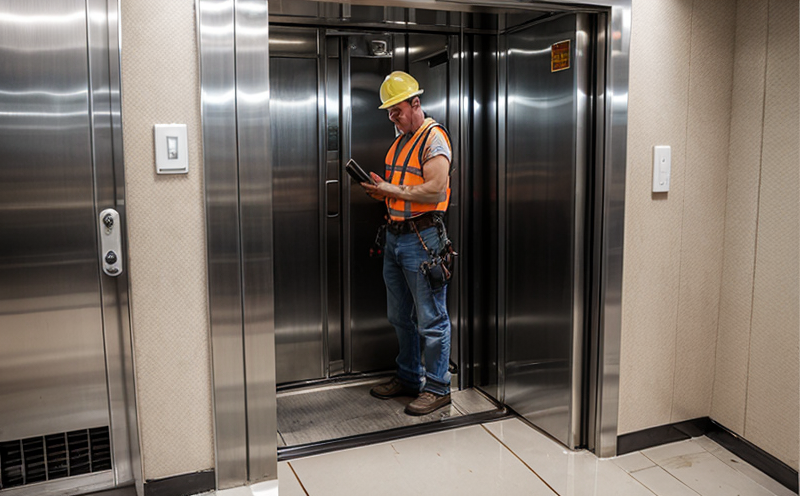Elevator ventilation inspection
The elevator ventilation inspection is a critical aspect of maintaining safety and regulatory compliance in elevators and escalators. Ensuring proper ventilation systems are not only essential for the comfort and health of passengers but also plays a vital role in preventing malfunctions that could lead to accidents.
Effective ventilation helps maintain air quality, reduces odors, prevents the buildup of contaminants such as dust and allergens, and ensures the indoor environment is at an acceptable temperature and humidity level. This inspection includes checking for adequate airflow, proper installation of ventilation ducts, filters, and fans, and ensuring that all components are functioning correctly.
The importance of this service cannot be overstated in sectors where public safety is paramount, such as office buildings, hotels, shopping malls, hospitals, and residential complexes. In these environments, the elevator ventilation system must meet stringent standards to ensure a safe and comfortable experience for users. Failure to maintain proper ventilation can lead to issues like mold growth, poor air quality, and even potential health hazards.
The inspection process involves detailed assessments of various components including but not limited to grilles, ducts, fans, filters, and sensors. It also includes testing the system’s ability to handle a range of operational conditions, from initial installation to high-traffic periods. Regular inspections are critical for identifying potential issues before they escalate into larger problems that could compromise safety.
Regulatory compliance is another crucial aspect of elevator ventilation inspection. Elevator systems must meet international standards such as ISO 13725, which specifies the acoustic environment in buildings, and ASME A17.1, which sets out the requirements for safe operation and maintenance of elevators, escalators, and moving walks.
Understanding the scope of elevator ventilation inspection helps stakeholders appreciate the comprehensive nature of this service. It ensures that all aspects of the ventilation system are thoroughly examined and maintained to industry standards, contributing to a safer and more comfortable environment for everyone using these facilities.
Why It Matters
Elevator ventilation inspection is not just about meeting regulatory requirements; it’s about ensuring public safety and enhancing the overall user experience. Proper ventilation directly impacts indoor air quality, which can significantly affect health and comfort levels of those using elevators.
The importance of this service becomes even more evident when considering the frequency and duration of elevator usage in various sectors. In busy commercial buildings like office complexes or shopping centers, elevators are used multiple times throughout the day by numerous individuals. Ensuring that these systems operate efficiently can prevent discomfort due to poor air quality and potential health risks associated with inadequate ventilation.
From a safety perspective, regular inspection of elevator ventilation ensures that any issues related to airflow or component malfunctions are addressed promptly. This proactive approach helps avoid situations where faulty ventilation could lead to accidents or injuries. It also supports the reliability of the entire system, which is crucial for maintaining trust and confidence among users.
In terms of compliance with international standards, elevator ventilation inspection plays a significant role in ensuring adherence to guidelines set forth by organizations such as ISO 13725 and ASME A17.1. These standards provide clear criteria that must be met for elevators to function safely and effectively. By adhering strictly to these standards during inspections, service providers can demonstrate their commitment to quality assurance and continuous improvement.
Moreover, the impact of proper elevator ventilation extends beyond just operational efficiency; it contributes positively towards sustainability efforts by promoting energy-efficient practices within buildings equipped with elevators. Efficiently designed and maintained ventilation systems help reduce energy consumption while simultaneously improving air quality inside confined spaces like elevators.
Applied Standards
Elevator ventilation inspection is governed primarily by international standards such as ISO 13725, which specifies the acoustic environment in buildings, and ASME A17.1, which sets out detailed guidelines for safe operation and maintenance of elevators, escalators, and moving walks.
- ISO 13725: This standard provides specifications on how to measure sound levels within different types of rooms in buildings. While it doesn’t directly relate to ventilation, it plays an indirect role by ensuring that noise generated from the operation of elevators does not interfere with proper airflow.
- ASME A17.1: This is one of the most widely recognized standards globally for elevator safety and maintenance. Section 8 specifically addresses ventilation requirements stating that “the manufacturer shall provide instructions regarding the installation, testing, inspection, cleaning, and replacement of ventilating units.” Compliance with this section ensures that elevators have adequate ventilation systems capable of providing fresh air to passengers.
These standards are crucial because they ensure consistent quality across all inspections performed globally. They help prevent inconsistencies in interpretation by clearly defining what constitutes acceptable performance levels for elevator ventilation systems.
Industry Applications
- Commercial Buildings: In large office complexes, shopping malls, and hotels where elevators are frequently used, regular inspections are essential to maintain optimal air quality. These inspections ensure that the ventilation systems are functioning correctly, thereby enhancing occupant comfort and safety.
- Hospitals: Hospitals require constant monitoring of their elevator ventilation due to hygiene concerns. Proper ventilation helps prevent the spread of airborne pathogens, ensuring a safer environment for patients and staff alike.
- Residential Complexes: Multi-story residential buildings often rely on elevators as primary means of vertical transportation. Regular inspections help identify potential issues early on before they escalate into more serious problems requiring costly repairs or replacements.
- Public Transport Facilities: Escalators and moving walkways at train stations, airports, and other public transport hubs are subject to rigorous testing due to high foot traffic. Proper ventilation is vital here not only for passenger comfort but also to maintain hygiene standards.
The applications listed above highlight the diverse range of environments where elevator ventilation inspection services can add value. By addressing specific needs within each sector, this service contributes significantly towards creating safer, healthier, and more efficient building operations.





